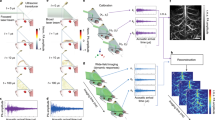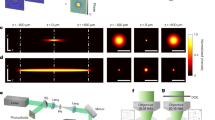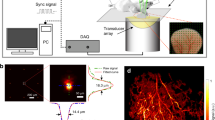Abstract
Photoacoustic tomography (PAT) has demonstrated versatile biomedical applications, ranging from tracking single cells to monitoring whole-body dynamics of small animals and diagnosing human breast cancer. Currently, PAT has two major implementations: photoacoustic computed tomography (PACT) and photoacoustic microscopy (PAM). PACT uses a multi-element ultrasonic array for parallel detection, which is relatively complex and expensive. In contrast, PAM requires point-by-point scanning with a single-element detector, which has a limited imaging throughput. The trade-off between the system cost and throughput demands a new imaging method. To this end, we have developed photoacoustic topography through an ergodic relay (PATER). PATER can capture a wide-field image with only a single-element ultrasonic detector upon a single laser shot. This protocol describes the detailed procedures for PATER system construction, including component selection, equipment setup and system alignment. A step-by-step guide for in vivo imaging of a mouse brain is provided as an example application. Data acquisition, image reconstruction and troubleshooting procedures are also elaborated. It takes ~130 min to carry out this protocol, including ~60 min for both calibration and snapshot wide-field data acquisition using a laser with a 2-kHz pulse repetition rate. PATER offers low-cost snapshot wide-field imaging of fast dynamics, such as visualizing blood pulse wave propagation and tracking melanoma tumor cell circulation in mice in vivo. We envision that PATER will have wide biomedical applications and anticipate that the compact size of the setup will allow it to be further developed as a wearable device to monitor human vital signs.
This is a preview of subscription content, access via your institution
Access options
Access Nature and 54 other Nature Portfolio journals
Get Nature+, our best-value online-access subscription
$29.99 / 30 days
cancel any time
Subscribe to this journal
Receive 12 print issues and online access
$259.00 per year
only $21.58 per issue
Buy this article
- Purchase on Springer Link
- Instant access to full article PDF
Prices may be subject to local taxes which are calculated during checkout







Similar content being viewed by others
Data availability
All data generated or analyzed within this study are included in the article and ref. 10. The raw data for Figs. 2 and 3 can be downloaded via the following links: Fig. 2, https://figshare.com/articles/dataset/Data_for_Fig_2/12950798; Fig. 3, https://figshare.com/articles/dataset/Data_for_Fig_3/12591953. All other raw data are available from the corresponding author upon request.
Code availability
The reconstruction algorithm and data processing methods are described in detail in this protocol. The reconstruction algorithm is provided with this protocol as Supplementary Software 1.
References
Weber, J., Beard, P. C. & Bohndiek, S. E. Contrast agents for molecular photoacoustic imaging. Nat. Methods 13, 639–650 (2016).
Ntziachristos, V. Going deeper than microscopy: the optical imaging frontier in biology. Nat. Methods 7, 603–614 (2010).
Wang, L. H. V. & Hu, S. Photoacoustic tomography: in vivo imaging from organelles to organs. Science 335, 1458–1462 (2012).
Zhang, H. F., Maslov, K. & Wang, L. V. In vivo imaging of subcutaneous structures using functional photoacoustic microscopy. Nat. Protoc. 2, 797–804 (2007).
Beard, P. C. Biomedical photoacoustic imaging. Interface Focus 1, 602–631 (2011).
Xu, M. & Wang, L. V. Universal back-projection algorithm for photoacoustic computed tomography. Phys. Rev. E Stat. Nonlin. Soft Matter Phys. 71, 016706 (2005).
Matthews, T. P., Poudel, J., Li, L., Wang, L. V. & Anastasio, M. A. Parameterized joint reconstruction of the initial pressure and sound speed distributions for photoacoustic computed tomography. SIAM J. Imaging Sci. 11, 1560–1588 (2018).
Li, L. et al. Single-impulse panoramic photoacoustic computed tomography of small-animal whole-body dynamics at high spatiotemporal resolution. Nat. Biomed. Eng. 1, 0071 (2017).
Wang, L. V. & Yao, J. A practical guide to photoacoustic tomography in the life sciences. Nat. Methods 13, 627–638 (2016).
Li, Y. et al. Snapshot photoacoustic topography through an ergodic relay for high-throughput imaging of optical absorption. Nat. Photonics 14, 164–170 (2020).
Li, L. et al. Small near-infrared photochromic protein for photoacoustic multi-contrast imaging and detection of protein interactions in vivo. Nat. Commun. 9, 2734 (2018).
Zhang, P. et al. High-resolution deep functional imaging of the whole mouse brain by photoacoustic computed tomography in vivo. J. Biophotonics 11, e201700024 (2018).
Zhang, P., Li, L., Lin, L., Shi, J. & Wang, L. V. In vivo superresolution photoacoustic computed tomography by localization of single dyed droplets. Light Sci. Appl. 8, 36 (2019).
Jathoul, A. P. et al. Deep in vivo photoacoustic imaging of mammalian tissues using a tyrosinase-based genetic reporter. Nat. Photonics 9, 239–246 (2015).
Yao, J. et al. Multiscale photoacoustic tomography using reversibly switchable bacterial phytochrome as a near-infrared photochromic probe. Nat. Methods 13, 67–73 (2016).
Wu, Z. et al. A microrobotic system guided by photoacoustic computed tomography for targeted navigation in intestines in vivo. Sci. Robot. 4, eaax0613 (2019).
Li, L. et al. Label-free photoacoustic tomography of whole mouse brain structures ex vivo. Neurophotonics 3, 035001 (2016).
Yeh, C. et al. Dry coupling for whole-body small-animal photoacoustic computed tomography. J. Biomed. Opt. 22, 41017 (2017).
Razansky, D. et al. Multispectral opto-acoustic tomography of deep-seated fluorescent proteins in vivo. Nat. Photonics 3, 412–417 (2009).
Imai, T. et al. High-throughput ultraviolet photoacoustic microscopy with multifocal excitation. J. Biomed. Opt. 23, 1–6 (2018).
Qu, Y. et al. Dichroism-sensitive photoacoustic computed tomography. Optica 5, 495–501 (2018).
Razansky, D., Buehler, A. & Ntziachristos, V. Volumetric real-time multispectral optoacoustic tomography of biomarkers. Nat. Protoc. 6, 1121–1129 (2011).
Li, L., Zhu, L., Shen, Y. & Wang, L. V. Multiview Hilbert transformation in full-ring transducer array-based photoacoustic computed tomography. J. Biomed. Opt. 22, 76017 (2017).
Laufer, J. et al. In vivo preclinical photoacoustic imaging of tumor vasculature development and therapy. J. Biomed. Opt. 17, 056016 (2012).
Ellwood, R., Ogunlade, O., Zhang, E., Beard, P. & Cox, B. Photoacoustic tomography using orthogonal Fabry–Pérot sensors. J. Biomed. Opt. 22, 41009 (2016).
Li, L. et al. Fully motorized optical-resolution photoacoustic microscopy. Opt. Lett. 39, 2117–2120 (2014).
Yao, J. et al. High-speed label-free functional photoacoustic microscopy of mouse brain in action. Nat. Methods 12, 407–410 (2015).
Hsu, H.-C. et al. Dual-axis illumination for virtually augmenting the detection view of optical-resolution photoacoustic microscopy. J. Biomed. Opt. 23, 1–7 (2018).
Draeger, C. & Fink, M. One-channel time reversal of elastic waves in a chaotic 2D-silicon cavity. Phys. Rev. Lett. 79, 407 (1997).
Ing, R. K., Quieffin, N., Catheline, S. & Fink, M. In solid localization of finger impacts using acoustic time-reversal process. Appl. Phys. Lett. 87, 204104 (2005).
Li, Y., Wong, T. T., Shi, J., Hsu, H.-C. & Wang, L. V. Multifocal photoacoustic microscopy using a single-element ultrasonic transducer through an ergodic relay. Light Sci. Appl. 9, 1–7 (2020).
Li, Y. et al. Photoacoustic topography through an ergodic relay for functional imaging and biometric application in vivo. J. Biomed. Opt. 25, 1–8 (2020).
Fink, M. & de Rosny, J. Time-reversed acoustics in random media and in chaotic cavities. Nonlinearity 15, R1 (2001).
Eder, F. X. Moderne Messmethoden der Physik. Bd 1. 2., erweiterte Aufl. Edn (Deutscher Verlag der Wissenschaften, 1960).
Bioucas-Dias, J. M. & Figueiredo, M. A. T. A new TwIST: two-step iterative shrinkage/thresholding algorithms for image restoration. IEEE Trans. Image Process. 16, 2992–3004 (2007).
Acknowledgements
This work was supported in part by National Institutes of Health grants R01 CA186567 (NIH Director’s Transformative Research Award), R01 NS102213, U01 NS099717 (BRAIN Initiative), R35 CA220436 (Outstanding Investigator Award) and R01 EB028277.
Author information
Authors and Affiliations
Contributions
L.L. and Y.L. developed the imaging system. L.L., Y.L. and Y.Z. designed and performed the experiments. L.V.W. supervised the study. All authors contributed to writing the manuscript.
Corresponding author
Ethics declarations
Competing interests
L.V.W. has financial interests in Microphotoacoustics, Inc.; CalPACT, LLC; and Union Photoacoustic Technologies, Ltd., which did not support this work.
Additional information
Peer review information Nature Protocols thanks Miya Ishihara, Guenther Paltauf and the other, anonymous, reviewer(s) for their contribution to the peer review of this work.
Publisher’s note Springer Nature remains neutral with regard to jurisdictional claims in published maps and institutional affiliations.
Related links
Key references using this protocol
Li, Y. et al. Nat. Photonics 14, 164–170 (2020): https://doi.org/10.1038/s41566-019-0576-2
Li, Y. et al. J. Biomed. Opt. 25, 070501 (2020): https://doi.org/10.1117/1.JBO.25.7.070501
Li, Y. et al. Light Sci. Appl. 9, 135 (2020): https://doi.org/10.1038/s41377-020-00372-x
Supplementary information
Supplementary Software 1
Software for PATER reconstruction
Supplementary Data 1
3D model and parts list for the animal holder
Rights and permissions
About this article
Cite this article
Li, L., Li, Y., Zhang, Y. et al. Snapshot photoacoustic topography through an ergodic relay of optical absorption in vivo. Nat Protoc 16, 2381–2394 (2021). https://doi.org/10.1038/s41596-020-00487-w
Received:
Accepted:
Published:
Issue Date:
DOI: https://doi.org/10.1038/s41596-020-00487-w
Comments
By submitting a comment you agree to abide by our Terms and Community Guidelines. If you find something abusive or that does not comply with our terms or guidelines please flag it as inappropriate.



